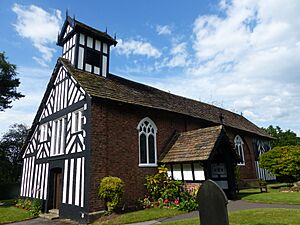All Saints Church, Siddington facts for kids
Quick facts for kids All Saints Church, Siddington |
|
|---|---|

All Saints Church, Siddington
|
|
| Lua error in Module:Location_map at line 420: attempt to index field 'wikibase' (a nil value). | |
| OS grid reference | SJ 845 708 |
| Location | Siddington, Cheshire |
| Country | England |
| Denomination | Anglican |
| Website | All Saints, Siddington |
| History | |
| Status | Parish church |
| Dedication | All Saints |
| Consecrated | 1521 |
| Architecture | |
| Functional status | Active |
| Heritage designation | Grade II* |
| Designated | 14 April 1967 |
| Architectural type | Church |
| Completed | 1894 |
| Specifications | |
| Materials | Timber framing enclosed in brick Kerridge stone-slate roof |
| Administration | |
| Parish | All Saints, Siddington |
| Deanery | Congleton |
| Archdeaconry | Macclesfield |
| Diocese | Chester |
| Province | York |
All Saints Church is a beautiful old church located in the village of Siddington, Cheshire, England. It's a special building because it's listed as a Grade II* historic site, meaning it's very important and protected. This church is an active Anglican parish church, which means it's a place where people in the local area come to worship. It's part of a larger group of churches in the diocese of Chester.
Contents
A Look Back at All Saints Church
Records show that there was a chapel in Siddington as early as 1337. Another record mentions it again in 1474. The church was officially set aside for preaching in 1521.
Originally, the building was made with a special method called timber-framed construction. This means it had a strong wooden frame. By 1815, the walls started to bulge outwards. To fix this, the timber frame was made stronger by adding brick around it. The church also had major repairs and updates in 1853 and again in 1894.
Exploring the Church's Design
Outside the Church
The front part of the church, called the chancel, and the south entrance porch still have their original timber-framing. The back wall, on the west side, is painted to look like timber-framing. The roof is made of special stone slates from a place called Kerridge.
The church's layout includes a main area called the nave with four sections. There's also a chancel with two sections. A small room called a vestry sticks out from the north wall of the chancel. There is also a porch on the south side. At the very west end of the church, there is a small tower for bells, known as a bellcote.
Inside the Church
The wooden roofs inside the nave and chancel are very old and well-preserved. A wooden screen from the 14th century separates the nave from the chancel. The chancel walls show the original timber-framing. The brick walls of the nave are painted to look like timber.
Most of the church's furniture and fittings are newer. However, the pulpit, which is where the priest gives sermons, is quite old, dating back to 1633. A balcony, or gallery, was built at the west end of the church in 1786.
The church's official records, called parish registers, started in 1722. The records of the churchwardens, who manage the church's money, began in 1781. Sadly, all the church's special silver and gold items were stolen in 1792 and were never found. A new set of these items was given to the church in 1936 by the Bromley-Davenport family.
Features Around the Church
The churchyard is the area around the church where people are buried. Here, you can find the graves of the Bromley-Davenport family, who lived nearby at Capesthorne Hall. There is also a stone cross base from the 16th century in the churchyard. This cross base is also a listed building, meaning it's historically important.
The churchyard also contains war graves. These are the burial sites of a soldier from the Tank Corps and two officers from the Royal Air Force who died during World War I.
Special Memorials
Inside the church, there is a memorial dedicated to Lieutenant Colonel Wilfrith Elstob. He was a brave soldier who received the Victoria Cross, which is the highest award for bravery in the British armed forces. He also received other important awards like the Distinguished Service Order (DSO) and the Military Cross (MC). He fought in World War I, and his father used to be the Vicar (priest) of All Saints Church.
See also
- Grade II* listed buildings in Cheshire East
- Listed buildings in Siddington, Cheshire

